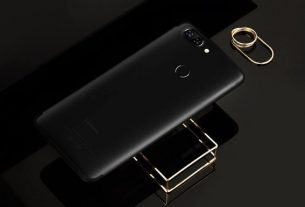Asus ZenFone 4 Selfie Pro is equipped with a 5.5-inch display with an aspect ratio of 16: 9. The display has large top and bottom bezels, the latter containing a fingerprint scanner and navigation buttons. The thickness of this case is 6.9 millimeters. Based on such a thin case, Asus minimizes the protrusion of the rear camera. Thanks to its rounded corners, the device feels good.
The case is made of frosted metal at the rear. There are three colors to choose from, black, red and a combination of gold and white. The case feels high quality and stability. We found it difficult to bend the device, and we only heard a quiet creak when we managed to minimize the bend. Nor can we affect the device by applying pressure forward or backward.
ZenFone 4 Selfie Pro has 4 GB of RAM and 64 GB of internal storage, and these combinations are comparable to smartphones of the same price. The device supports microSD card expansion or dual SIM card slots. The second SIM card slot doubles as a microSD card slot, which means you have to choose between microSD card expansion capabilities and a single nano-SIM card or dual SIM card function. microSD can only be formatted as external memory, so applications can only be stored in internal memory. FM radio support, the device uses a headphone cable as an antenna.
ZenFone 4 Selfie Pro is not equipped with NFC, while charging and data transfer are handled through a micro-USB 2.0 port.
The device comes with Android Nougat 7.1.1 and security patches released in December 2017. Although Android Oreo should launch, it was unavailable at the time of testing. Hopefully the system updates are consistent with the updated security patches as they are a bit dated during our testing time.
Asus uses ZenUI on ZenFone 4 Selfie Pro to make minor visual changes to Android’s inventory and pre-install some additional apps. There is a theme gallery that allows further UI modifications. In addition, ASUS has installed the Mobile Manager application, which blocks cached data and notifications for each application, and also supports security scanning for it. Facebook’s application suites are pre-installed, but you can uninstall them.
ZenFone 4 Selfie Pro supports 802.11 b / g / n WiFi, which means that the device cannot connect to a 5 GHz WiFi network, nor can it take advantage of fast AC WiFi. Our test equipment did not perform well in our standard WiFi tests. ZenFone 4 Selfie Pro can only reach 1/7 to 1/5 of the speed achieved by Wiko WIM or Galaxy A8. Even if the device is close to the router and the signal is complete, the web page will load slower than our comparison device. When we tested ZenFone 4 Selfie Pro ten meters and three walls away from the router, the difference in WiFi speed was even more dramatic.
Only 7 LTE bands are supported, which is the choice of Asus, which limits the ZenFone 4 Selfie Pro to a few countries. Although these bands are suitable for using the device in Central Europe, you may find it difficult to find signals further afield. To make matters worse, the download and upload speeds of the supported bands are not particularly fast. We measured download speeds of up to 150 Mbit / s and upload speeds of 50 Mbit / s. In comparison, Honor 9 offers a maximum download speed that is twice that of our test device. It is worth noting that the Chinese version of ZenFone 4 Selfie Pro has faster data transmission speed, while Westerners must use LTE Cat. 4.
Even by the window, ZenFone 4 Selfie Pro couldn’t find a place indoors. Outdoors, we found that GPS takes a long time to find a location, and it can only find a location with accuracy to 20 meters.
We then used the ZenFone 4 Selfie Pro on the bike to measure the GPS accuracy of the Garmin Edge 500, a professional GPS-based bicycle computer. Compared to our previous tests, the ZenFone 4 Selfie Pro handles cycling well, placing us on our route accurately, with a slight deviation from the Edge 500. So, although GPS takes time to use, we would recommend it as a navigation device when it finds your location.
Asus has changed the stock phone app because call history is opened via the keyboard. There are tabs for contacts and settings, many of them. There are even custom options, Asus already includes dark themes, different fonts, and the option to select a background image.
The call quality is good. Overall, the sound sounds clean and clear, although there is no depth of sound. We noticed that a lot of sounds became harsh. Despite the reverberation, the sound of the speakers is understandable.
Asus already knows the selling point of this product, because the product is called Selfie Pro, and this is reinforced by printing “We Love Photo” on the box. To reach its name, the ZenFone 4 Selfie Pro is equipped with dual 12 MP sensors, one of which has a regular focal length and the other with a 120 ° wide-angle lens. What’s more, the software stitches together images taken by two sensors, effectively creating a 24 MP image. This leads to beautiful photos that are detailed and well lit. The main front camera shoots well, while the quality of the telephoto lens is subjective. Has a strong fish-eye effect, with obvious distortion at the edges of the image. This produces interesting group selfies, with people on the edge of the shot looking more like they are in an interesting twisted mirror place.
The main camera has a 16 MP sensor for relatively good photos. These lack the brightness, detail, and clarity of high-quality optics, such as those found in the OnePlus 5T. 4K video can be captured using the front and rear cameras, but only up to 30 FPS. Although the quality is passable, the color looks a bit pale and there is visible motion blur.
ZenUI keyboard is based on the popular Swype keyboard application. There are many settings and many input options including word prediction, swipe and voice dictation. These options ensure quick and intuitive use of the keyboard. Although the Asus ZenUI keyboard is the default, you can change this keyboard by downloading a different keyboard from the Play Store.
The touch screen is very sensitive and stays in the corner of the display. In addition, Asus includes glove mode, so the device can be easily used in cold weather. The fingerprint scanner works well, recognizes your fingers quickly and unlocks the device from standby mode. This is also a home button with touch-sensitive areas on both sides responsible for the task manager and back button. There are also gesture controls handled by ZenMotion. This can be found in the settings.
ZenFone 4 Selfie Pro is equipped with Qualcomm Snapdragon 625 SoC, while graphics are processed by Qualcomm Adreno 506. This is the current popular SoC choice for mid-range smartphones, even though Qualcoom has released a slightly more powerful Snapdragon 626 with its power Yongguang WIM. ZenFone 4 Selfie Pro and Wiko WIM performed equally well, with the Galaxy A8 slightly better. On the front are Honor 9 and Nokia 8 thanks to their high-end SoC. In daily use, these performance differences are negligible, because even the slowest device in the benchmark has enough power to handle almost all current applications.
There is a speaker on the bottom edge of the device. This sounds good and produces better bass and midrange than other similarly priced devices. This produces a warm sound, occasionally interrupted by unpleasant treble. Asus includes an outdoor mode designed to optimize sound in noisy environments. In fact, this mode is of limited use because high frequencies are significantly enhanced, producing uncomfortable sound in all environments except the most noisy.
ZenFone 4 Selfie Pro performed better than all comparison devices in our WiFi test, albeit just. Our test equipment was managed for nearly 11 hours, 4 minutes longer than the next best comparison device. Due to its energy efficiency, 3000 mAh battery capacity exceeds those with slightly larger batteries. In daily use, ZenFone 4 Selfie Pro should be able to easily complete the whole working day, and it can be easily used for one hour. Fast charging is supported, which means that the battery can be fully charged in about 90 minutes.
Asus has brought some colors to our test lab, and its trend is hot. ZenFone 4 Selfie Pro has more features besides coloring, it can achieve its marketing and name. The 24 megapixel DuoPixel mode requires great selfies, and wide-angle lenses can be used to create interesting effects, including fish-eye effects. Photo software has many useful functions. At the same time, the main camera took decent photos for mid-range smartphones.
If you’re looking for a smartphone that takes good pictures, look no further. Asus ZenFone 4 Selfie Pro can do a lot of things with just some compromises. WiFi, GPS and internal storage may be faster. Similarly, pre-installed software is usually a double-edged sword, and brighter displays can be useful for outdoor use. Although the performance is good, the battery life is the same, the power consumption is low, it is still cool even under load, and the speakers are decent. ZenFone 4 Selfie Pro reads microSD cards quickly, has ample internal storage capacity, and has multiple input options.
We recommend ZenFone 4 Selfie Pro mainly because it does what it does and takes great selfies. This is a mid-range smartphone that usually takes good pictures.



BTS singers are going to be using this phone